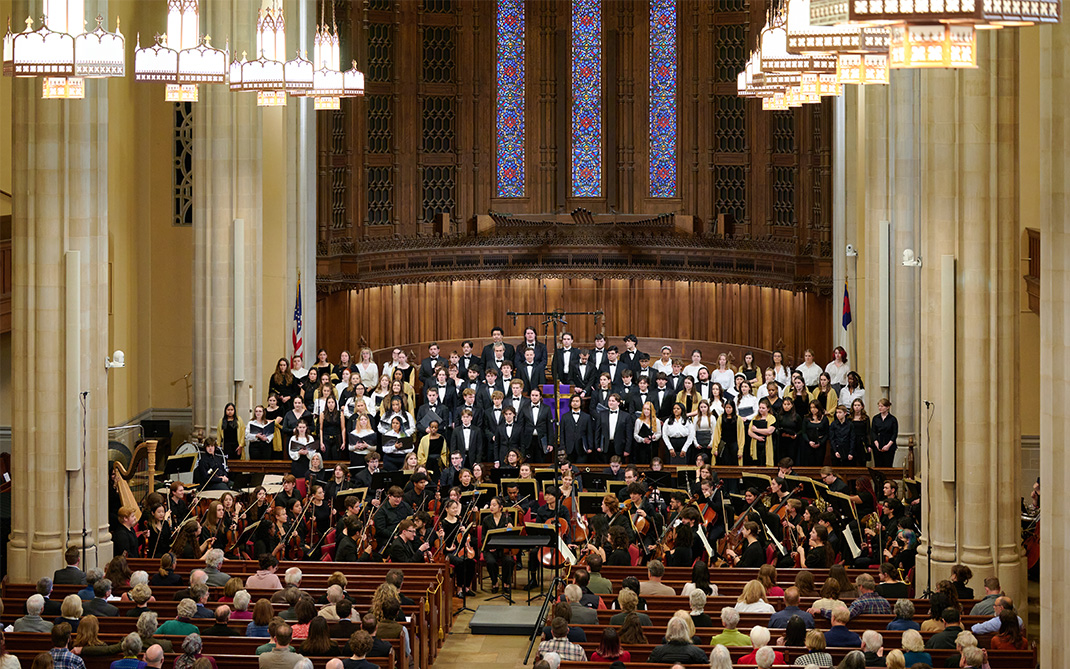Oscar Winner, alumnus Paul Tazewell on the art of world-building through costume
“This is absolutely astounding,” says Paul Tazewell holding his Oscar on stage at the 97th Academy Awards ceremony. “I am the first Black man to receive the costume design award for my work on ‘Wicked.’ I am so proud of this.”
What the School of Design & Production alumnus (B.F.A. ’86) has accomplished over his 30-year career is nothing short of extraordinary. A Tony, Emmy and now Academy-award winner, Tazewell has designed original costumes for dozens of Broadway shows, — including the wildly successful “Hamilton: An American Musical,” — as well as breathtaking ensembles for the silver screen. His credits include “Harriet,” “The Immortal Life of Henrietta Lacks,” “The Wiz! Live,” “West Side Story” and, of course, the much beloved film adaptation of “Wicked.”
Since graduating, Tazewell has kept his connection to UNCSA strong. He has returned as a visiting guest artist in the School of Design & Production (D&P) to share his knowledge with Costume Design and Technology students, inspired students as the commencement speaker in 2018, and served on the UNCSA Board of Trustees.

Tazewell has returned as a visiting guest artist in the School of Design and Production to share his knowledge with Costume Design and Technology students.
Discovering design
Growing up in Akron, Ohio, Tazewell set his sights on New York City early on. “I took trips to New York in high school,” he recalls. “And I knew I would do what I had to do to get there.”
After high school, he spent a year acting at the Pratt Institute, which is perhaps where the idea of being a costume designer began to take shape — Tazewell found himself not only acting in shows but designing costumes for them as well. He came to UNCSA as a sophomore, initially considering a double major in acting and costume design but soon found himself drawn fully into design. “There was not enough time to do both,” he remembers with a laugh.
At UNCSA, Tazewell gained hands-on experience researching, designing and constructing costumes for performances spanning a multitude of genres and time periods. He studied under John Sneden, Mark Pirolo, Clyde Fowler and Howard Jones, refining a traditional approach to classical theatre that still influences his work today.
The School of the Arts has been life-changing for me. I have realized just how much of an effect it’s had on my growth overall … the school is so much a part of who I am and how I relate to people.
Paul Tazewell
Tazewell’s decision to pursue costume design was shaped, in part, by the industry’s limitations at the time. Though he loved performing, he aspired to play leading roles, including in historical productions like Shakespeare. “There was not as much opportunity for African American actors in those roles,” he explains. "With costume design, I thought, ‘I can do whatever shows I want.’ I wouldn’t be typecast by the color of my skin.”
After earning his B.F.A., he went on to study at NYU’s Tisch School of the Arts, graduating with his M.F.A. in 1989. The following year, he launched his professional career — and he hasn’t slowed down since.
Hamilton
Though he had been well known in the industry for years, Tazewell became a household name with Lin Manuel Miranda’s semi-biographical musical “Hamilton: An American Musical.” His Tony-winning designs played a crucial role in the show’s revolutionary visual storytelling.
“It’s a modern piece, written in modern language,” he says. “But these were real people from a real time, a definite year.” He grappled with the challenge: How do you honor the period while embracing the show’s contemporary style?

A selection of Paul Tazewell's renderings for "Hamilton: An American Musical."
Extensive historical research guided his approach. For the first staged reading at the Public Theatre, Tazewell outfitted actors from a vast stock of 18th century costumes “It turned out to be the most compelling way to tell the story,” he says.
Still, subtle modern influences were woven in. “For me, it’s very important to design in a way so that the actors can relate to the clothing in a contemporary way,” he explains. The result? A seamless blend of past and present that continues to being the beloved Broadway show — and its characters — to life.
Following the yellow brick road
Though “Wicked” — directed by Jon M. Chu and starring Cynthia Ervino and Ariana Grande — is Tazewell’s most recent journey to Oz, it’s far from his first. “I've probably done five, six productions of The Wiz,” he told Harper’s Bazaar in 2024.
“I did my first production when I was in high school...It means I have been immersed in this culture and the world of The Wizard of Oz for such a long time.” Most notably, his work on “The Wiz Live!” earned him the Emmy award for Outstanding Costumes for a Variety, Nonfiction, or Reality Program in 2016.
When the opportunity arose to design for the recent film adaptation of “Wicked,” Tazewell knew it would be a challenge unlike any before. The Broadway production of “Wicked” had a devoted fan base, and its visual world had to feel fresh yet familiar. His approach? A perfect balance between fantasy and realism, coupled with a meticulous attention to detail.
“There are so many close ups on small details,” he told Harper’s Bazaar. “I loved that, being able to be really intricate with what I was creating. You can go into the sort of detail you would never see on stage ... It’s important world-building.”
With the designs themselves, Tazewell took care to truly know the characters. “My priority was creating a balance between Elphaba and Glinda, and both are armored, in a way,” he told Harper’s Bazaar. “They dress the way that they, as young women, deal with life.”
A legacy in the making
Tazewell’s meticulous approach to costume design — whether for the grand scale of Broadway or the intimate lens of film — reflects his dedication to storytelling through every stitch and seam. His work on “Wicked” not only earned him an Academy Award but also reaffirmed his belief in the power of costume to shape character, transport audiences and build entire worlds.
From his early days at UNCSA to the pinnacle of Hollywood recognition, his journey is a testament to the impact of artistry, vision and an unwavering commitment to craft. And as he continues to push boundaries in design, one thing is certain — his magic is only just beginning.
Updated April 16, 2025; Originally published June 10, 2016






